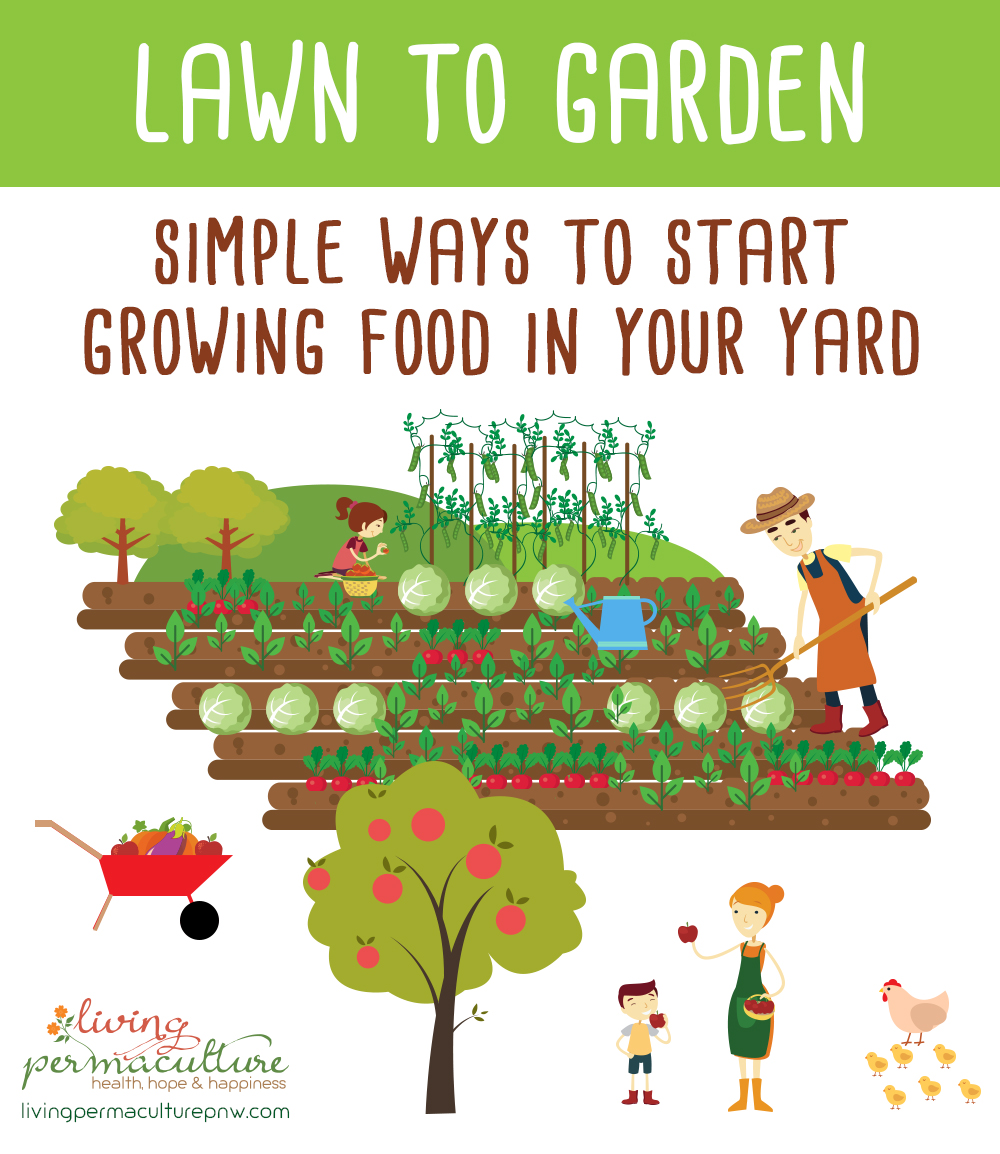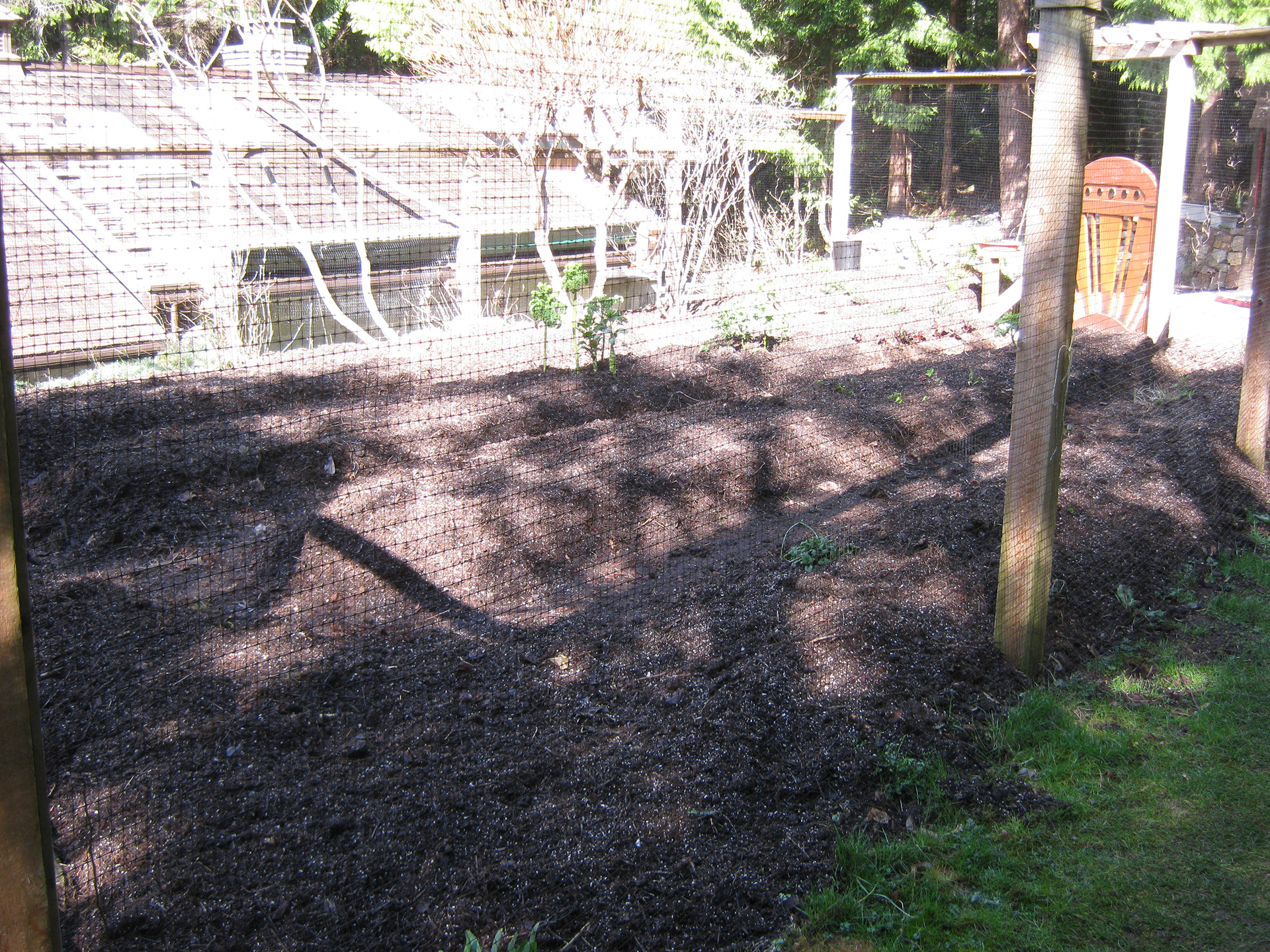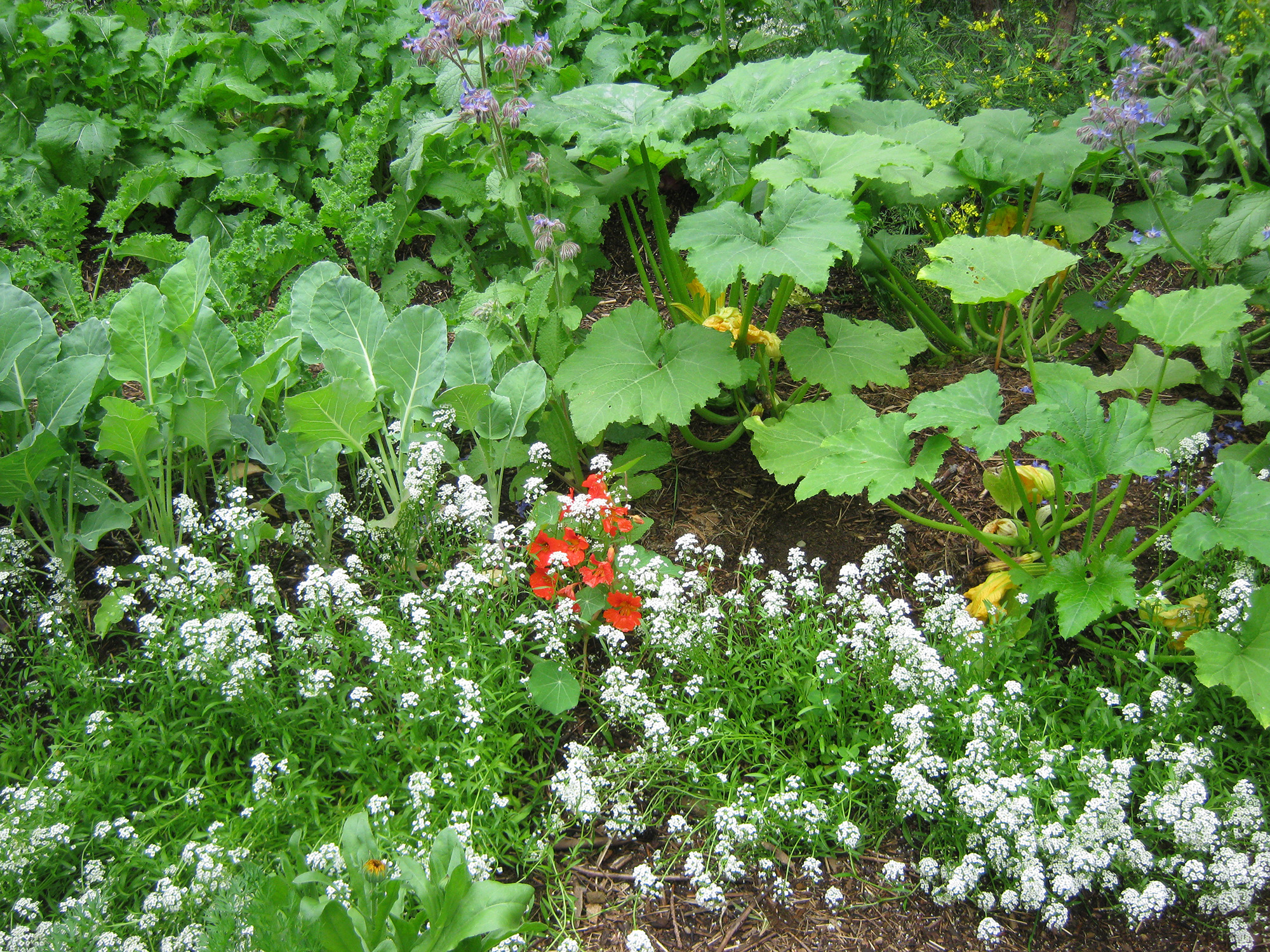
Lawns are kind of boring, don’t you think? Especially front lawns. How often do you actually see anyone on their front lawn, except when they’re mowing it? Not very often. People are much more likely to hang out in their backyards.
It might sound a bit harsh, but I think lawns should be illegal. What if we could work toward getting bylaws passed in our respective towns and cities that prohibited lawns, and encouraged productive gardens instead? That would be pretty cool
There is a movement getting started right now (March 2020) that is working on setting up resources for people who want to start growing their own food. It is modeled on the Victory Gardens of the past, but the motivation is different.
This organization is called the Cooperative Gardens Commission. I’m getting involved, and helping spread the word. Sign-up, and get involved HERE.
Anyway, this group is going to help people learn to grow their own food. The COVID-19 pandemic is threatening many peoples’ livelihoods, and food security is a real concern. The shelves of many grocery stores are emptied as quickly as they are stocked; and people are afraid.
What better time to start gardening? Now is the time to turn your lawn to garden, and supply yourself – and your family, if you have one – with healthy, organic, and truly fresh vegetables. And just when you need them most.
Where do I start?
There are an infinite number of ways to design the layout of your yard. Luckily, permaculture offers you the means to make the right choices, and create the most productive space possible. Let’s look at some aspects of your yard that will dictate where you plant things, and what you might need to do first to get things ready.
- Where are the sunniest and shadiest places in your yard?
- What is the soil like – does it need amendments?
- Do you want raised beds, or an in-ground garden?
- Are there any shrubs and trees that you need to remove?
- What natural resources do you have access to: manure, leaves, wood chips, etc.?
Now let’s get started. There are lots of ways to approach designing a property. On a small property, like a city lot, it makes sense to start with a list of the plants you want to grow.
You can create a small food forest; or just have a straight up vegetable garden; or you can go for a mix – some trees and berry bushes around the edges, and a vegetable garden in the main part of the yard.
Make a sketch of the layout of the yard – or if you’re comfortable with it, do it on your computer. Put in the big things that can’t be moved – trees, buildings – so you can see where the shady and sunny areas will be. Do some measuring to get the square footage of the space you’re designating for food production.
Now you can start placing plants and trees into the design, moving things around until you are pleased with the layout. In order to get things right, you’ll need to know how big the trees and shrubs will get when mature, and how far apart they should be space.
While the trees and shrubs are still small, you can grow annuals around them. Once they have matured, you’ll want to grow other things such as alpine strawberries for a ground cover, and perhaps a nice grapevine to climb the now mature tree. You can check out this thread to see what kinds of plants are good to grow in a fruit tree guild.
In the meantime, you will want to design your vegetable garden. Many people prefer to build raised beds; and there is definitely a place for them. Tall ones are great for people who have a hard time bending down; or for places where you can’t grow directly in the soil. But it’s not the only way to build a garden.
I prefer to have raised beds that aren’t contained. When you build a wooden box to put your soil in, you lose quite a bit of growing area. A raised bed without sides can give you twice as much growing space or more, depending on how tall they are. And they’re far easier and less expensive to build.
But it doesn’t matter what kind of garden you want to build; all that matters is that you build one. Once you taste your first harvest of fresh, homegrown vegetables, you’ll be hooked.

Keep it simple
One of the tenets of permaculture is to try to get more energy out of a system than you put in. In the case of a garden, the energy put in is your time, work, and money, and the energy you get out is the produce you grow.
People always think that gardening takes up a lot of time, and you have to spend a few hours a day working the garden. But that really isn’t the case. A well-built garden needs very little tending. So a stroll through in the evening should be enough time to catch up on any stray weeds, keep on top of pest problems, and harvest veggies for dinner.
We’ve got creeping buttercup. A lot of it. It keeps trying to work its way in from the edges of the garden, but I just spend a little time now and then, and try to get as much of the roots as possible. I know I’ll never get rid of it all, so I don’t stress over it. I have other weeds that pop up here and there – dandelion, plantain, chickweed – but they are all useful weeds, so I don’t worry about them, and just let them grow.
Aside from weeding, the only work that needs to be done during the growing season is watering, planting seeds and transplants, and harvesting. Sure, you might scatter some mulch here and there, or spread some compost before reseeding a bed, but nothing outrageous.
On a city lot, growing your own food is not going to take a lot of your time. And the time it does take will repay you many times over when you harvest your fresh organic veggies.
The key to having a maintenance-free garden is spending the time to build it well, and practicing the no-dig method. Digging the soil has two effects: it disturbs the soil food web, and it stirs up weed seeds. So every time you till, you’re setting the soil back by disturbing its ecosystem; and you’re bringing more seeds to the surface, making you have to weed more often.
I learned of the no-dig method by watching Charles Dowding’s videos. He is the no-dig champion. And it’s a very simple system. You simply smother the existing weeds, then spread a layer of compost on top, and add compost yearly, without ever tilling the soil. That’s it! A wonderfully easy and low-maintenance system.
Another great garden building method is called hugelkultur. I built my garden using this method – rotten logs covered with soil and organic matter. After the beds are built, there is no tilling or digging the soil again. .
The benefits of hugelkultur are:
- the logs absorb water during the rainy season, and release it to the veggies during the summer.
- the logs decay over time, providing much fertility.
- you can create raised beds without purchasing soil.
If you use the buried wood method, you will have a raised bed garden that doesn’t need tilling, and so doesn’t stir up weed seeds to contend with every year. It will eventually become quite hydrated, relatively weed-free, and extremely fertile. Just keep adding a layer of compost every year, and it will become an excellent, low-maintenance garden.
Those are just a couple of the many ways to build a garden. The type you choose depends on how much work you can put into it, and the resources you have at your disposal. I was lucky to have a garden building partner with a truck who knew the area, and we’ve spent many lovely days gathering resources for the garden.
Make your garden attractive
Perhaps you live somewhere where having an attractive yard is mandatory. That’s okay. There is nothing in the rule book that says a productive permaculture garden can’t also be attractive. Flowers are an important aspect of any growing system, because they attract pollinators and beneficial insects. So don’t think that you can’t make things pretty.
Most fruit trees and berry bushes flower in the spring, putting on a lovely show. And just the variety of greens of garden vegetables is lovely. But you can also grow different colored veggies. There’s purple kohlrabi and broccoli, colorful kales, as well as the beautifully colored flowers of peas and beans.
No matter what you decide to grow, it might stand out in the neighborhood as ‘different’ for a while, but once people get used to it, it just might convince others to do the same. Invite your neighbors over to tour your newly designed yard. Explain how everything was built, how easy it is to maintain, and share some produce with them.
That’s the best way to spread the word, and get more people growing their own food. You don’t have to even talk about permaculture if they’re not ready for that. Just plant the seed in their minds, and hope that they get as excited about growing their own food as you are.
From suburban lawn to garden
It doesn’t take much to turn a lawn into a garden. If you want raised beds, or need to make your garden conform to local bylaws, you’ll have to put in a little more work, and probably a little more money. But if you keep it simple, it really doesn’t have to cost much, or take much time.
There are also other tools that we can use from the permaculture toolbox: greywater systems for watering the trees and shrubs; succession planting; seed saving; and making your own compost, are all ways to increase your production, save money, and lessen your footprint on the planet.
There has never been a more important time to start a garden. With everything that is happening in the world today, learning to grow our own food is fast becoming one of the most important skills we can learn.
And don’t even get me started on corporate take over of our food systems! That just gets me riled up. But I’ll talk about it one day in another article and get you thinking about where your food comes from, and who is in charge of the seeds.
In the meantime, get out there and start planning your garden. Get your seeds ordered, get the soil ready, and have an excellent gardening season.
If you have any questions or comments, please feel free to pop them in the box below.
Health, Hope & Happiness
Tracy
This article may contain affiliate links. If you click on a link and make a purchase, I will receive a small commission, at no extra cost to you. See the full Affiliate Disclosure here.

I really enjoyed reading your article. I’ve always wanted to start my own garden and I agree now it’s the best time to do it. I live in a flat but my grandpa has his own house with a garden so I’ll be able to use some of your tips to help him plant some vegetables.
Thanks for the informative post:)
Hi Agnes;
I hope that you’re able to glean some knowledge from my site and apply it to your grandpas garden. Maybe you can read this article, and help him find more places to grow food in his yard. That way you can help him increase his harvest!
It really is important to learn to take control of your food supply system. And now is exactly the time to do it.
Thanks for stopping by and commenting.
Tracy
Hi Tracy,
Interesting article, thanks for sharing your tips and knowledge! The weeding is certainly the bane of my gardening, along with moss coming up in the pavement.
I’ve often considered growing strawberries or some kind of berries, however, I hear they can be difficult to mind. Would you have any thoughts on that?
Hi Sharon;
I find berries to be quite easy to take care of. The main task – besides picking them – is to cut out the old canes (for raspberries), or thinning the runners (strawberries). But that is generally a once a year task. Berries are actually fairly low maintenance. Saskatoon berries (my childhood favorite from growing up in northern British Columbia) are totally maintenance free.
As for weeds – a heavy mulch to smother them, and adopting a no-till way of gardening will eventually eradicate them.
Thanks for stopping by; and keep asking questions.
Tracy
Like many others during the covid 19 lockdowns in my country, I have found like many others I have been in the garden with the kids, transforming it to a level I never thought possible! I now have a blank canvas to do what I want with and we have planned to plant some strawberries, coming across your post has come at the perfect time!
I found the getting started section most useful as its now made me need to analyze what plants and part of the garden to utilize. I am lucky that most of the garden gets sun all year round.
I also need to examine the soil in the garden, One thing I wanted to ask is how can find out what type of soil you also what you would need?
I have a big pile of twigs and branches from trimming my trees and bushes in my garden last year, will they do for the hugelkultur process?
Truth is, I don’t think that’s harsh at all. I think lawns should truly be illegal. They don’t really add value to anyone. They’re just there because so many have bought in this lie that you have to have one. I feel it’s this symbol of wealth or supposed social status that’s as pointless as watering the plants in rain. There truly are much better ways how to use that space. Making an amazing garden: arguably the best one.
I found the hugelkultur to be an absolutely fascinating approach to this. I will have to try that.
And truly. I would even go as far as to say that just the thought/visualization alone of me tasting fresh fruit and vegetables of my first harvest got me hooked. I would absolutely love to not be so reliant on the grocery stores.
Above all, I full-heatedly agree. There has never been a more important time to start a garden.
Cheers.
Hi Matiss I’m so glad to hear that you have the same ideals when it comes to lawns. What a waste of perfectly good gardening space! I truly hope that you work toward creating your own garden.Take a stroll through some of my other articles and see the different possibilities. And if you have any questions at all, please don’t hesitate to ask! My mission is to get as many people growing their own gardens as possible!
Stay safe.
Tracy